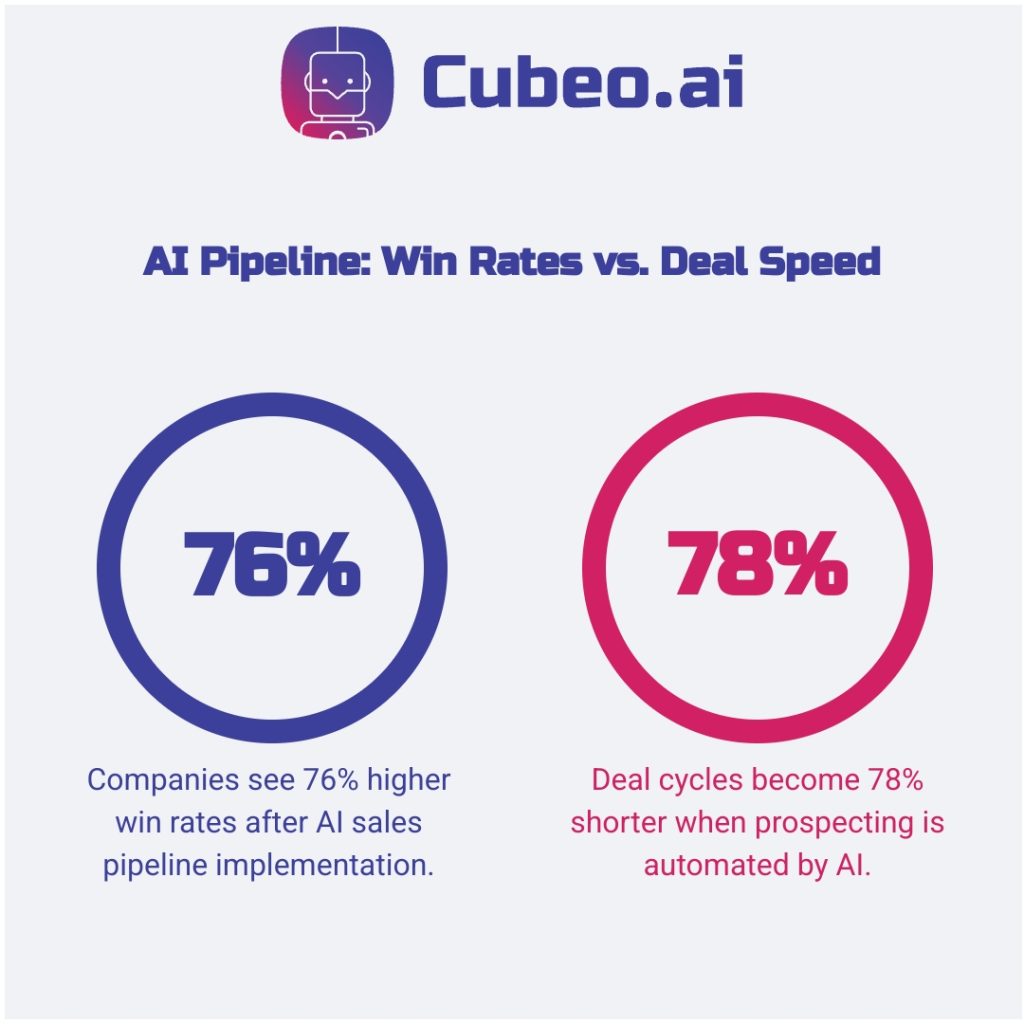Sales teams waste 72% of their time on manual prospecting tasks that AI can automate in minutes. Your reps spend hours researching LinkedIn profiles, copying contact details, and crafting cold emails. According to Salesforce research, reps spend only 28% of their time actually selling (State of Sales Report).
Here’s how automation works: CRM lead created → auto-enrich contact details → score by conversion likelihood → draft personalized email → push to rep for approval and send.
The 3-stage AI prospecting pipeline:
- Discover: Lead Finder agents match prospects to your Ideal Customer Profile automatically
- Qualify: Enrichment fills missing contact fields while scoring ranks leads by conversion potential
- Engage: Email Crafter drafts personalized messages using LinkedIn activity and company signals
Teams using this comprehensive AI prospecting implementation achieve 80% reduction in research time and 50% increase in qualified leads through coordinated agent workflows.
Your next step involves mapping specific data requirements and governance guardrails for production deployment.

3-Stage AI Prospecting Pipeline
Modern prospecting works when specialized agents coordinate through event-based triggers that move prospects from discovery to qualified handoff automatically.
Quick blueprint: CRM lead created → auto-enrich contact data → score conversion likelihood → draft personalized outreach → queue for rep review and send.
One-hour setup checklist:
1. Connect Lead Finder to your CRM for automatic prospect capture
2. Set enrichment fields: email, phone, job title, company details
3. Configure scoring threshold (recommend 80+ for high-priority routing)
4. Create outreach queue with rep review workflow
5. Set Slack notifications for qualified handoffs
Companies implementing AI sales pipeline automation report 76% higher win rates and 78% shorter deal cycles. This automated prospecting pipeline approach transforms how teams discover, qualify, and engage prospects at scale.
Stage 1: Discover ICP Matches
You set Lead Finder agents to scan LinkedIn, Crunchbase, and company databases for prospects matching your Ideal Customer Profile (your targeting criteria for perfect customers). Configure searches based on:
- Firmographics: Company size, industry, revenue, employee count
- Technographics (the apps and tools companies use): Software stack, CRM systems, technology adoption patterns
- Behavioral signals (recent company activities): Funding rounds, job postings, leadership changes
Trigger example: New company matches ICP criteria → automatically capture contact details → enrich with verified email and LinkedIn profile → push to CRM with “Stage 1 Complete” tag.
Primary KPI (Stage 1): ICP match rate — percentage of discovered companies meeting target criteria (goal: ≥20% of new captures).
Stage 2: Qualify Leads
Your enrichment agents fill missing contact and company information while scoring algorithms rank prospects by conversion probability. AI prospecting studies show 30-50% higher lead conversion rates within 90 days of implementation.
Data enrichment fills:
- Verified email addresses and phone numbers
- Job titles, reporting structure, decision-making authority
- Company funding history, recent news, competitive landscape
Scoring triggers: Lead enrichment complete → calculate fit score (0-100) based on ICP alignment → assign engagement priority → route high-scoring leads (80+) to senior reps.
Stage 3: Engage and Handoff
Email Crafter agents generate personalized outreach using real-time prospect insights from LinkedIn activity, company announcements, and industry trends. This AI agent implementation enables hyper-personalized messaging that increases engagement rates significantly.
Personalization sources:
- Recent LinkedIn posts, job changes, company updates
- Industry challenges, competitive moves, funding announcements
- Mutual connections, shared interests, relevant content engagement
Engagement triggers: High-priority lead identified → draft personalized email → queue for rep review → send approved message → track opens/clicks → trigger follow-up sequence based on response behavior.
Human handoff occurs when: Prospect replies with interest → meeting request sent → calendar link shared → rep receives Slack notification with full prospect research and conversation history.

Data Enrichment and Lead Scoring
Poor data quality costs companies 12% of revenue annually, while enriched leads generate 30% bigger deals and close 25% faster.
Trigger (copy/paste): CRM lead created → auto-enrich contact & company fields → if score ≥ 80, route to senior rep; else add to nurture queue.
Primary KPI: Enrichment fill rate — target ≥ 90% within 30 days.
Random outreach wastes time. Systematic data collection and simple scoring tell you who to call now. Companies implementing AI lead scoring case studies report 215% increases in qualified leads through analyzing over 10,000 data points per prospect.
Enrichment Data Schema
Your data foundation requires standardized fields across all prospect sources. Design your schema around 3 core categories:
Contact Data:
- Verified email addresses and phone numbers
- Job title, seniority level, reporting structure
- LinkedIn profile, recent activity, mutual connections
Company Data:
- Firmographics: Revenue, employee count, industry, location
- Technographics (the apps a company runs, e.g., HubSpot, Salesforce): Software stack, CRM system, marketing tools
- Recent signals: Funding rounds, leadership changes, job postings
Behavioral Data:
- Website visits, content downloads, email engagement
- Social media activity, event attendance, webinar participation
- Buying committee interactions and decision timeline indicators
This no-code AI implementation ensures consistent enrichment across LinkedIn, company websites, and news feeds without technical complexity.
AI Scoring Models
Machine learning algorithms analyze historical conversion patterns to rank prospects by likelihood to buy. Weight 3 factor categories:
Company Fit (40% weight):
- ICP alignment score based on size, industry, technology stack
- Budget indicators from funding history and growth signals
- Decision-making authority and procurement processes
Engagement Level (35% weight):
- Website behavior, content consumption patterns
- Email opens, clicks, and response rates
- Social media interactions and referral sources
Timing Signals (25% weight, recent company activities showing buying readiness):
- Recent company changes, expansion plans, competitive moves
- Budget cycles, contract renewal dates, implementation timelines
- Buying committee formation and vendor evaluation activities
Quality Governance
Production-ready scoring requires continuous monitoring and validation. Implement these governance guardrails:
Data Validation Rules:
- Email verification and bounce rate monitoring
- Phone number format validation and reachability checks
- Company information accuracy through multiple source verification
Scoring Model Monitoring:
- Weekly accuracy audits comparing predicted vs actual conversions
- Monthly model recalibration based on new conversion data
- Quarterly threshold adjustments for changing market conditions
Productivity research shows systematic governance maintains scoring accuracy while reducing manual data management overhead by 60%.
Your next step involves translating these enriched, scored leads into personalized outreach that converts prospects into meetings.

Personalized Outreach and Handoff
Trigger example: Email opened → AI drafts LinkedIn follow-up + phone call within 48 hours → rep receives qualified handoff with full context.
Turn enriched data into meetings this week. AI-driven personalized outreach like Guild Mortgage’s implementation doubled lead response speed through prospect-specific messaging that references recent activity and company developments.
Your AI agents craft messages using real-time signals, track engagement behavior, and hand off warm prospects to reps with complete context for immediate follow-up.
AI Email Personalization
Generate personalized outreach using real-time prospect research from LinkedIn activity, company announcements and industry developments. Dynamic templates automatically adapt messaging based on lead score and profile data.
Key personalization triggers:
- Recent LinkedIn post → reference specific content in opening line
- Company funding news → congratulate and tie to growth challenges
- Job change announcement → acknowledge new role and responsibilities
Template variables:
- {{recent_activity}} pulls latest LinkedIn posts or company updates
- {{mutual_connections}} identifies shared network contacts
- {{pain_point}} matches prospect’s role to relevant business challenges
A/B testing optimizes subject lines and messaging for higher open rates across all personalized sequences.
Engagement Automation
Behavioral triggers initiate follow-up sequences based on prospect actions. Monitor email opens, link clicks, and social media engagement to determine next steps automatically.
Multi-channel trigger sequences:
- Email opened but no reply → LinkedIn connection request after 2 days
- Link clicked → phone call attempt within 24 hours
- LinkedIn profile viewed → personalized follow-up email referencing mutual interests
- No engagement after 3 touches → move to long-term nurture sequence
Performance KPIs:
- Outreach booking rate: 2-4% of all outbound messages book meetings
- Open rates: Target 35-45% for cold outreach
- Response rates: Target 8-12% for personalized sequences
Human Handoff Process
Intent signals trigger automatic assignment to sales representatives when prospects demonstrate buying readiness. Your CRM receives complete prospect context with enriched data and full interaction history.
Handoff trigger criteria:
- Prospect replies with meeting request or pricing inquiry
- Multiple email opens plus LinkedIn profile visits within 48 hours
- Website demo page visits or pricing page engagement
- Direct phone call return or voicemail response
Context transfer includes:
- Complete enrichment data (contact, company, behavioral signals)
- Personalization sources used in outreach messages
- Engagement timeline with opens, clicks, and responses
- Recommended talking points based on prospect’s interests
This CRM integration workflow ensures seamless transitions from automation to human relationship building.
Primary KPI: Handoff conversion rate — 25-35% of leads routed to reps book meetings within 7 days (higher than outreach-level rate because routing concentrates high-quality leads).




